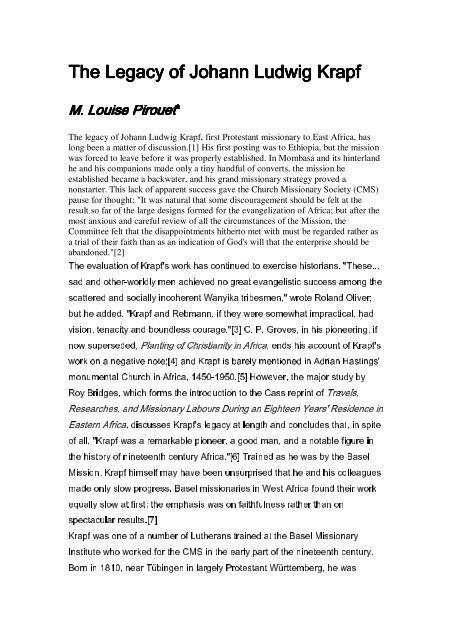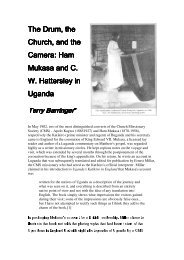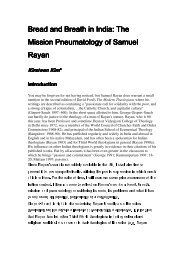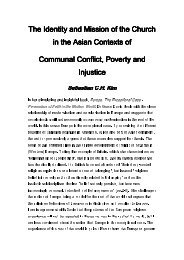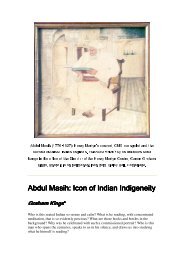The Legacy of Johann Ludwig Krapf - Henry Martyn Centre
The Legacy of Johann Ludwig Krapf - Henry Martyn Centre
The Legacy of Johann Ludwig Krapf - Henry Martyn Centre
Create successful ePaper yourself
Turn your PDF publications into a flip-book with our unique Google optimized e-Paper software.
<strong>The</strong> <strong>The</strong> <strong>Legacy</strong> <strong>Legacy</strong> <strong>of</strong> <strong>of</strong> <strong>Johann</strong> <strong>Johann</strong> <strong>Ludwig</strong> <strong>Ludwig</strong> <strong>Ludwig</strong> <strong>Krapf</strong><br />
<strong>Krapf</strong><br />
<strong>The</strong> legacy <strong>of</strong> <strong>Johann</strong> <strong>Ludwig</strong> <strong>Krapf</strong>, first Protestant missionary to East Africa, has<br />
long been a matter <strong>of</strong> discussion.[1] His first posting was to Ethiopia, but the mission<br />
was forced to leave before it was properly established. In Mombasa and its hinterland<br />
he and his companions made only a tiny handful <strong>of</strong> converts, the mission he<br />
established became a backwater, and his grand missionary strategy proved a<br />
nonstarter. This lack <strong>of</strong> apparent success gave the Church Missionary Society (CMS)<br />
pause for thought: "It was natural that some discouragement should be felt at the<br />
result so far <strong>of</strong> the large designs formed for the evangelization <strong>of</strong> Africa; but after the<br />
most anxious and careful review <strong>of</strong> all the circumstances <strong>of</strong> the Mission, the<br />
Committee felt that the disappointments hitherto met with must be regarded rather as<br />
a trial <strong>of</strong> their faith than as an indication <strong>of</strong> God's will that the enterprise should be<br />
abandoned."[2]<br />
Pirouet* Louise M.<br />
Louise Pirouet M. Louise Pirouet M. Louise Pirouet M.<br />
evaluation <strong>of</strong> <strong>Krapf</strong>'s work has continued to exercise historians. "<strong>The</strong>se... sad and other-worldly men achieved no great evangelistic success among the scattered and socially incoherent Wanyika tribesmen," wrote Roland Oliver; but he added. "<strong>Krapf</strong> and Rebmann, if they were somewhat impractical, had <strong>The</strong><br />
tenacity and boundless courage."[3] C. P. Groves, in his pioneering, if now superseded, Planting <strong>of</strong> Christianity in Africa, ends his account <strong>of</strong> <strong>Krapf</strong>'s work on a negative note;[4] and <strong>Krapf</strong> is barely mentioned in Adrian Hastings' monumental Church in Africa, 1450-1950.[5] However, the major study by Roy Bridges, which forms the introduction to the Cass reprint <strong>of</strong> Travels, vision,<br />
and Missionary Labours During an Eighteen Years' Residence in Eastern Africa, discusses <strong>Krapf</strong>'s legacy at length and concludes that, in spite <strong>of</strong> all, "<strong>Krapf</strong> was a remarkable pioneer, a good man, and a notable figure in the history <strong>of</strong> nineteenth century Africa."[6] Trained as he was by the Basel Mission, <strong>Krapf</strong> himself may have been unsurprised that he and his colleagues Researches,<br />
only slow progress. Basel missionaries in West Africa found their work equally slow at first; the emphasis was on faithfulness rather than on spectacular results.[7] made<br />
was one <strong>of</strong> a number <strong>of</strong> Lutherans trained at the Basel Missionary Institute who worked for the CMS in the early part <strong>of</strong> the nineteenth century. Born in 1810, near Tübingen in largely Protestant Württemberg, he was<br />
<strong>Krapf</strong>
in Pietism. In Travels, Researches, and Missionary Labours in East Africa he tells us little about his family except that his father was a comfortably-<strong>of</strong>f farmer and that he was one <strong>of</strong> four children. He seems to have been an overserious child; he suffered a six-month-long illness following a severe beating for a fault he did not commit, and reported, 'Left to myself my immersed<br />
dwelt much upon eternity; and the reading <strong>of</strong> the Bible and devotional books became my delight."[8] He might never have gone beyond elementary schooling, but as the result <strong>of</strong> a chance encounter by his sister, he was sent to the Österbergschule in Tübingen, where he received an education that prepared him for university.[9] thoughts<br />
school he quickly caught up with his contemporaries and then outstripped them, soaking up languages like blotting paper. He learned Latin and Greek and made a start on French and Italian; when he decided to go to the Basel At<br />
Institute, he prepared himself by learning Hebrew and before long had "read the greater portion <strong>of</strong> the Old Testament in the original."[10] He spent from May 1827 to May 1829 at Basel but then came to doubt his missionary call, and he returned to Tübingen to spend the next five years studying theology.[11] He was ordained in the autumn <strong>of</strong> 1834. After less than Missionary<br />
year's not altogether happy parish experience, he met Peter Fjellstedt, a Basel-trained Swedish missionary, who rekindled his missionary call and encouraged him to <strong>of</strong>fer to the CMS.[12] He returned to Basel, where, in 1836, he met Dandeson Coates, lay secretary <strong>of</strong> CMS, and was accepted by that society. When assigned to Ethiopia, he set to work to study "Aethiopic," a<br />
known as Ge'ez, the archaic language <strong>of</strong> the church, and Amharic, the modern speech <strong>of</strong> the Christian Amhara people, besides studying some Arabic. He also read the History <strong>of</strong> Ethiopia by the great seventeenth-century properly<br />
Vision in Ethiopia<br />
<strong>Krapf</strong>'s first posting was to Ethiopia, where he worked from 1837 to 1842, when he<br />
was forced to return to Cairo. Here he made his first long overland journey, and<br />
armed already with some knowledge <strong>of</strong> Ge'ez and Amharic, he set out to master the<br />
Cushitic speech <strong>of</strong> the Oromo people (whom he knew as the Galla), the dominant<br />
people throughout much <strong>of</strong> central and southern Ethiopia. His first publications date<br />
scholar Hiob Ludolf.[13] Vision in Ethiopia Vision in Ethiopia Vision in Ethiopia German
from this period, with translations <strong>of</strong> the Gospels <strong>of</strong> John and Matthew into Oromo, as<br />
well as a first grammar and vocabulary. In 1842 his pioneering linguistic<br />
achievements were recognized when he was awarded an honorary doctorate at<br />
Tübingen University. He became obsessed with the idea that the Oromo, whom he<br />
described as "the most intellectual people <strong>of</strong> Eastern Africa,"[14] were the key to the<br />
evangelization <strong>of</strong> the continent, and when driven out <strong>of</strong> Ethiopia, he determined to<br />
reach them via Mombasa. <strong>The</strong> Journals <strong>of</strong> the Rev. Messers Isenberg and <strong>Krapf</strong>,<br />
Missionaries <strong>of</strong> the Church Missionary Society was published in 1843. It consists <strong>of</strong><br />
edited extracts from <strong>Krapf</strong>'s journals with much shorter additions from Isenberg's<br />
letters, and although not in the first rank <strong>of</strong> writings on Ethiopia, it contains valuable<br />
information about the theological controversies that were raging in the Ethiopian<br />
church at that date, as well as about the people and politics, and the land itself and its<br />
geography. Journals also records a whole series <strong>of</strong> conversations in which <strong>Krapf</strong> appeared to do little but win debating points about religion. Yet in fact he got <strong>The</strong><br />
well with the king and with his visitors, many <strong>of</strong> them priests and debtera (men and boys skilled in singing the liturgy), who visited him again and again. He taught a small group <strong>of</strong> men and boys gathered round him, reading the Scriptures with them and teaching them "universal history" and geography. He seems to have been accepted as another kind <strong>of</strong> religious teacher with his on<br />
<strong>of</strong> disciples. It is impossible to understand why people continued to visit and talk with him unless these visits were more cordial and less one-sided than his diary suggests. Probably his visitors enjoyed theological debate, and there was plainly more to the conversations than he records; his extensive knowledge <strong>of</strong> Ethiopian religious literature and customs was the result <strong>of</strong> circle<br />
and other conversations. <strong>Krapf</strong>'s pietism, with its emphasis on individual conversion and personal religious experience, made it virtually impossible for him to understand or these<br />
Ethiopian Christianity, which was bound up with ethnic identity rather than being a matter <strong>of</strong> personal belief. He compared it with medieval European Christian practice and belief and thought it stood in equal need <strong>of</strong> reformation. He could not understand why people preferred the Scriptures in Ge'ez, the ancient church language, which they could not comprehend, to the appreciate<br />
translation, in which, as a good Lutheran, and believing in the importance for salvation <strong>of</strong> the Scriptures in a people's own tongue, he tried to interest them.[15] But he did recognize that the only way to get people to accept the Amharic translation was to print it together with the Ge'ez,<br />
Amharic
Having experienced the imperviousness <strong>of</strong> the Ethiopian Orthodox Christians to his<br />
Protestant and Pietist interpretations <strong>of</strong> Scripture, and their unreadiness for a<br />
reformation, he turned to the Oromo, convinced that they were the key to the<br />
conversion <strong>of</strong> Africa. When his position became intolerable in Ethiopia because <strong>of</strong><br />
political machinations, he made his way down the East Coast <strong>of</strong> Africa to Zanzibar<br />
and then across to Mombasa, in order to try to reach the Oromo by another route. Yet<br />
oddly he stayed in and around Mombasa for years, not seeming to realize that his<br />
inland journeys would not take him anywhere near the Oromo, who lived far to the<br />
north. <strong>The</strong> idea that they would be the key to the evangelization <strong>of</strong> Africa proved to<br />
be pure fantasy.<br />
<strong>The</strong> Mombasa Years<br />
eleven years, 1844-1855, <strong>Krapf</strong> worked in the coastal area <strong>of</strong> modern Kenya, first in Mombasa, where his wife, Rosina, and her newborn next the For<br />
arranged in parallel columns, and he worked to persuade the Bible Society to accept the need for this for many years.[16] That no amount <strong>of</strong> reading Romans with Ethiopian priests would bring them to see salvation through Lutheran eyes was something else he could not understand. He did, however, come to question his initial outright rejection <strong>of</strong> the practice <strong>of</strong> preferably<br />
which played such a large part in Ethiopian Christian practice, though there is no evidence that he actually joined them in fasting.[17] Ethiopian church music sounded cacophonous to his ears, and he lacked any appreciation <strong>of</strong> their liturgy. fasting,<br />
Mombasa Years <strong>The</strong> Mombasa Years <strong>The</strong> Mombasa Years <strong>The</strong><br />
both died, and then at Rabai, on a ridge a few miles inland. Of all the missionaries sent out to work with him, only <strong>Johann</strong>es Rebmann, who joined him in 1846, and who outstayed him by many years, remained for any length <strong>of</strong> time. It was not long before <strong>Krapf</strong> was engaged in language study, working first on Kiswahili (he quickly recognized its debt to Arabic), and then on Kinika child<br />
the language <strong>of</strong> the people now known as the Mijikenda. Vocabularies <strong>of</strong> other East African languages, including Maasai, followed. However, it was Rebmann's translation into Kiswahili that was eventually printed by the British and Foreign Bible Society, even if it was <strong>Krapf</strong>'s orthography that was adopted and <strong>Krapf</strong> who saw it through the press.[18] (Kirabai),<br />
missionaries became widely known, not for their missionary work or for their work in translating the Bible but for their journeys into the interior, the<br />
Both
which they published showing great inland lakes <strong>of</strong> which they had been told, speculations about the source <strong>of</strong> the Nile, and their sightings <strong>of</strong> the snow-covered peaks <strong>of</strong> Mounts Kilimanjaro and Kenya. British geographers who had never been near Africa argued fiercely about their findings, and these writings whetted the appetites <strong>of</strong> geographers and travelers and maps<br />
exploration <strong>of</strong> the interior. <strong>Krapf</strong>'s Reisen in Ost-Afrika in two volumes was published in Stuttgart in 1858, and the shorter one-volume English edition, Travels and Researches, two years later. Both this and the earlier Journals were <strong>of</strong> sufficient importance to scholarship to be reprinted in the 1960s, as was his Swahili dictionary. encouraged<br />
was in fact Rebmann, not <strong>Krapf</strong>, who first sighted a snow-capped mountain on his second inland journey in April to June 1848. <strong>The</strong> following year <strong>Krapf</strong> made his first long inland journey when he reached Ukambani, sighting both It<br />
and Kenya. <strong>The</strong> journey to Ukambani was particularly difficult because he had to traverse the almost waterless thorn scrub that stretches some two hundred miles inland from the coast behind Rabai. He was entirely dependent on the goodwill <strong>of</strong> those whose land he traversed, and he was not always welcome. A second journey to Ukambani followed in 1851, from which Kilimanjaro<br />
had to turn back because <strong>of</strong> the hostility <strong>of</strong> the Kamba. <strong>The</strong> missionaries had had no more success earlier in locating a mission in Usambara further to the south. In spite <strong>of</strong> these setbacks <strong>Krapf</strong> remained determined that the correct missionary strategy was to establish a chain <strong>of</strong> mission stations at fifty-mile intervals to link East Africa with the already <strong>Krapf</strong><br />
missions in West Africa, but in this he did not have the support <strong>of</strong> Rebmann or <strong>of</strong> <strong>Johann</strong> Erhardt, also Basel-trained missionaries. <strong>The</strong>y both became discouraged by the lack <strong>of</strong> response <strong>of</strong> the coastal peoples. But <strong>Krapf</strong> established<br />
to this idea doggedly. In 1863 he was still convinced that the CMS would soon reach the Oromo via Rabai, and the same year he was thinking in terms <strong>of</strong> a chain <strong>of</strong> missions from Jerusalem to Abyssinia. In September 1853 <strong>Krapf</strong> left Rabai for reasons <strong>of</strong> health for the last time and spent a year in England before revisiting Ethiopia, at the request <strong>of</strong> Bishop stuck<br />
Gobat <strong>of</strong> Jerusalem, to assess the possibilities for reestablishing mission work there, before finally settling back in Germany at Kornthal, a<br />
Samuel
<strong>The</strong> move back to Germany marked the beginning <strong>of</strong> a new phase <strong>of</strong> <strong>Krapf</strong>'s<br />
missionary activity, not his retirement from it. He became an adviser to others on<br />
mission work in eastern Africa, making several further visits to Africa in this<br />
connection, <strong>of</strong> which the 1853 visit to Ethiopia in connection with Bishop Gobat's<br />
mission was the first. In the years that followed he did what he could to raise support<br />
in Germany for this mission. <strong>The</strong> most significant <strong>of</strong> his African visits was that to<br />
East Africa in 1862 to help Thomas Wakefield <strong>of</strong> the United Methodist Free Church<br />
to found a mission there. He chose a site for the mission at Ribe, not far from Rabai,<br />
and it was both men's hope that this mission would be a stepping stone to the Oromo.<br />
Indeed, Methodist missionaries did make contact with some <strong>of</strong> the more southerly<br />
migrant Oromo, but this was not the breakthrough that had been hoped for.[20] <strong>The</strong><br />
Methodist Church in Kenya dates back to this pioneer mission. Roy Bridges has<br />
pointed out that <strong>Krapf</strong>'s influence in Germany was greater than in Britain. Several<br />
Lutheran missions that took up work in East Africa, including the Bavarian<br />
Evangelical Lutheran Mission founded in response to his death, owed something to<br />
the inspiration <strong>of</strong> his life and work.[21] <strong>The</strong>se later missions were to work under<br />
colonial rule, which broke open the self-containment <strong>of</strong> precolonial societies that had<br />
proved such a barrier to <strong>Krapf</strong> and his companions.<br />
A New Phase <strong>of</strong> Missionary Activity<br />
place in 1867-68, when <strong>Krapf</strong> accompanied the expedition led by Sir Robert Napier, which ended in the battle <strong>of</strong> Magdala. took Ethiopia to visit final A<br />
<strong>of</strong> Pietism, which became his home for the rest <strong>of</strong> his life. He married again in 1856, his second wife being Charlotte Pelargus, the eldest daughter <strong>of</strong> a city councilor <strong>of</strong> Stuttgart; they had one daughter, <strong>Johann</strong>a. Charlotte <strong>Krapf</strong> died in 1868, and the following year <strong>Krapf</strong> was married for the third time, to Nanette Schmidt von Cannstadt, who had been his housekeeper. <strong>The</strong>ir center<br />
lasted until <strong>Krapf</strong>'s own death in 1881.[19] A New Phase <strong>of</strong> Missionary Activity A New Phase <strong>of</strong> Missionary Activity A New Phase <strong>of</strong> Missionary Activity marriage<br />
was forbidden to engage in evangelism, though it was accepted that he might discuss religion with the Ethiopians if they raised the subject. Presumably he agreed to go with the expedition because he could not resist the opportunity <strong>of</strong> seeing Ethiopia once again, but he had to be invalided back to Germany after only three months.[22] <strong>Krapf</strong><br />
second major activity <strong>of</strong> these years was his work on languages and translation and the task <strong>of</strong> seeing translations <strong>of</strong> Scripture through the press, a topic that occupied so much <strong>of</strong> his later correspondence. His linguistic range was extraordinary, including two <strong>of</strong> the Semitic languages <strong>of</strong> Ethiopia (Amharic and Tigrinya), a Cushitic language (Oromo), Maasai, which is <strong>of</strong>ten<br />
A
as Nilo-Hamitic, and several Bantu languages. His observations on these and on the relationships and contrasts between them laid a basis for further ethnographic studies. Translations into Oromo, Kinika, Kiswahili, and Kikamba had appeared in the 1840s. In the next decade he compiled A Vocabulary <strong>of</strong> Six East African Languages, and a vocabulary <strong>of</strong> Maasai, as classified<br />
as writing a preface to a Maasai vocabulary by his colleague Rebmann. <strong>The</strong> 1860s saw him editing Debtera Matteos's Gospel translations into Tigrinya. At the end <strong>of</strong> the decade came his own Oromo translations <strong>of</strong> Luke and John. Next came work on Amharic, with Abba Rukh's translation <strong>of</strong> the Old Testament, which <strong>Krapf</strong> saw through the press, a major undertaking, in well<br />
because a special font <strong>of</strong> type had to be cut for the printing <strong>of</strong> the Amharic syllabary. <strong>The</strong>re followed Psalms, Genesis and Exodus, and the New Testament in Oromo, which <strong>Krapf</strong> worked on with an Oromo student, part<br />
and at last in 1876 the parallel edition <strong>of</strong> the New Testament in Ge'ez and Amharic that he had advocated for so many years. From 1859 onward there is a series <strong>of</strong> letters, covering almost twenty years, between him and the British and Foreign Bible Society, whose archive is now held by Cambridge University library. Some ninety manuscript letters from R<strong>of</strong>so,[23]<br />
covering the years 1826 to 1858 are held in the Basel Mission Archives, in addition to the huge collection <strong>of</strong> his writings in the CMS archives in Birmingham University.[24] <strong>The</strong> German Reisen in Ost-Afrika ausgeführt in den Jahren 1837-55 is in two volumes and is considerably longer than the English-language Travels and Researches. <strong>The</strong>re is, then, a vast collection <strong>of</strong> <strong>Krapf</strong><br />
his major legacy, which modern scholars continue to trawl through, for <strong>Krapf</strong> was a good observer at a time when there were few around, interested in every detail he could learn about the peoples <strong>of</strong> eastern Africa, writings,<br />
customs, and their countries.[25] <strong>The</strong>re is no modern biography <strong>of</strong> <strong>Krapf</strong>. In spite <strong>of</strong> the mass <strong>of</strong> writings that he left, the man remains rather remote. We can agree with Roland Oliver that he was "other-worldly" and "somewhat impractical," but that, on the other hand, he had "vision, tenacity and boundless courage," and that Bridges is right in their<br />
that he was a "remarkable pioneer, a good man, and a notable figure in the history <strong>of</strong> nineteenth century Africa." It is also apparent that he<br />
concluding
deeply imbued with the spirit <strong>of</strong> Pietism and had been molded by the discipline and religious seriousness <strong>of</strong> the Basel Institute. His letters and journals are full <strong>of</strong> religious comment that rises above mere platitude by reason <strong>of</strong> the difficult and sometimes dangerous circumstances in which they were written, even though expressed in somewhat clichéd terms. But the man was<br />
is difficult to discern; to some extent he is masked by his words rather than revealed through them. Whatever the success or otherwise <strong>of</strong> his work, the Anglican Church <strong>of</strong> the Province <strong>of</strong> Kenya (CPK), which celebrated its first century and a half <strong>of</strong> existence in 1994, looks back to him as its founder. In the volume produced to himself<br />
this occasion, Rabai to Mumias, <strong>Krapf</strong> and Rebmann and their companions occupy most <strong>of</strong> the first eleven pages <strong>of</strong> chapter 1. Photographs <strong>of</strong> both men are included. That they were Lutherans rather than Anglicans is mark<br />
* M. Louise Pirouet lectured in church history and African<br />
Christianity at Makerere University, Kampala, Uganda, and Nairobi<br />
University, Kenya, before returning to Britain, where she lectured in<br />
religious studies at Homerton College, University <strong>of</strong> Cambridge, until<br />
her retirement.<br />
mentioned. It is important to the CPK that these early missionaries did not high-handedly condemn African customs without understanding them and that their standard <strong>of</strong> living was simple and close to that <strong>of</strong> the people they lived among, unlike later missionaries whose standard <strong>of</strong> living distanced them from ordinary Africans.[26] For modern Kenyan Christians, <strong>Krapf</strong> was an barely<br />
missionary pioneer. Notes outstanding<br />
1. I am indebted to Paul Jenkins and Patricia Purtschert (Basel Mission<br />
Archives), Alan Jesson (Bible Society Archives, Cambridge Univ. Library),<br />
and Pr<strong>of</strong>essor Roy Bridges for help in preparing this article.<br />
2. Eugene Stock, <strong>The</strong> History <strong>of</strong> the Church Missionary Society: Its<br />
Environment, Its Men, and Its Work, 3 vols. (London: CMS, 1899), 2:135.<br />
3. Roland Oliver, <strong>The</strong> Missionary Factor in East Africa (London and New York:<br />
Longmans, Green, 1952), p. 6.<br />
4. C. P. Groves, <strong>The</strong> Planting <strong>of</strong> Christianity in Africa, vol. 2, 1840-1878<br />
(London: Lutterworth, 1954), pp. 116-17.<br />
5. Adrian Hastings, <strong>The</strong> Church in Africa, 1450-1950 (Oxford: Clarendon Press,<br />
1994).
6. R. C. Bridges, introduction to J. L. <strong>Krapf</strong>, Travels, Researches, and<br />
Missionary Labours in East Africa (London: Frank Cass, 1968; orig. ed.,<br />
London: Trübner, 1860), p. 65.<br />
7. Jon Miller, <strong>The</strong> Social Control <strong>of</strong> Religious Zeal (New Brunswick, N.J.:<br />
Rutgers Univ. Press, 1994), pp. 21-22.<br />
8. <strong>Krapf</strong>, Travels, p. 2.<br />
9. <strong>Krapf</strong> refers to this as the Anatolian School. <strong>The</strong> school was named after the<br />
Österberg, a hill east <strong>of</strong> Tübingen. This school taught Greek as well as Latin,<br />
hence the name was sometimes given as Anatolishe Schule (Greek en to<br />
anatole, "in the east"). I am grateful to Dr. H. Ehmer <strong>of</strong> the archives <strong>of</strong> the<br />
Evangelische Landeskirche in Württemberg for elucidating this point for me.<br />
10. <strong>Krapf</strong>, Travels, p. 10.<br />
11. Information prepared by H. Bächtold, Missionssekretär, Basel Mission, 1966.<br />
12. CMS, A Register <strong>of</strong> Missionaries and Native Clergy, 1804-1904 (London:<br />
CMS, 1905), p. 43. See also "Fjellstedt, Peter," in Biographical Dictionary <strong>of</strong><br />
Christian Missions, ed. Gerald H. Anderson (New York: Macmillan, 1998).<br />
For connections between Basel and the CMS, see Paul Jenkins, "<strong>The</strong> Church<br />
Missionary Society and the Basel Mission: An Early Experiment in Inter-<br />
European Co-operation," in CMS and World Christianity, 1799-1999, ed. K.<br />
Ward and B. Stanley (London and Grand Rapids, Mich.: Curzon Press and<br />
Eerdmans, 1999).<br />
13. <strong>Krapf</strong>, Travels, pp. 9, 11. Additional information about <strong>Krapf</strong>'s early life is<br />
contained in a three-page summary prepared by H. Bächtold, archivist <strong>of</strong> the<br />
Basel Mission, 1966.<br />
14. <strong>Krapf</strong> to H. Knolleke, March 3, 1860, Bible Society Archives (BSA),<br />
Cambridge Univ. Library, Editorial Correspondence Inwards 2.<br />
15. <strong>Krapf</strong> to Coates, copied to BFBS, February 20, 1841, BSA, Foreign<br />
Correspondence Inwards 3.<br />
16. Stock, History <strong>of</strong> the CMS, 1:227-28; entry for August 27, 1839, Journals <strong>of</strong><br />
the Rev. Mersers Isenberg and <strong>Krapf</strong>. (Reprint, Journals <strong>of</strong> C. W. Isenberg<br />
and J. L. <strong>Krapf</strong>, London: Frank Cass, 1968.) <strong>The</strong> printing <strong>of</strong> a parallel-text<br />
edition was finally seen through the press by <strong>Krapf</strong> in 1876 (BSA, Editorial<br />
Correspondence Inwards 12).<br />
17. Journals, p. 138.<br />
18. An example <strong>of</strong> his first Kiswahili translation is found in Church <strong>of</strong> the<br />
Province <strong>of</strong> Kenya, Rabai to Mumias (Nairobi: Uzima Press, 1994), pp. 5-7.<br />
19. Bächtold, 1966. Basel Archives. By this time <strong>Krapf</strong> seems to have lost touch<br />
with the CMS.<br />
20. "Wakefield, Thomas," in Biographical Dictionary <strong>of</strong> Christian Missions.<br />
21. Bridges, introduction to Travels, pp. 50-51.<br />
22. Ibid., pp. 47-48.<br />
23. <strong>Krapf</strong> to Secretary <strong>of</strong> the BFBS, February 21, 1867, BSA, Editorial<br />
Correspondence Inwards 5.<br />
24. Because his letters were sometimes copied by one society to the other, they<br />
may figure more than once.<br />
25. See, for instance, Bahru Zewde, A History <strong>of</strong> Modern Ethiopia, 1855-1974<br />
(London: James Currey, 1991); J. de Vere Allen, Swahili Origins (London:<br />
James Currey, 1993); Justin Willis, Mombasa, the Swahili, and the Making <strong>of</strong><br />
the Mijikenda (Oxford: Clarendon Press, 1993).<br />
26. Rabai to Mumias, pp. 8-10.
1843 - Journals <strong>of</strong> the Rev. Messers. Isenberg and <strong>Krapf</strong> Detailing their Proceedings<br />
in the Kingdom <strong>of</strong> Shoa and Journeys in Other Parts <strong>of</strong> Abyssinia in the Years 1839,<br />
1840, 1841, and 1842, with a Geographical Memoir by James McQueen. London:<br />
Trübner. Reprint, Journals <strong>of</strong> C. W. Isenberg and J. L. <strong>Krapf</strong>, London: Frank Cass,<br />
1968.<br />
1858 - Reisen in Ost-Afrika. 2 vols. Stuttgart. Reprint in one volume, Stuttgart: Hanno<br />
Beck, 1964.<br />
1860 - Travels, Researches, and Missionary Labours During an Eighteen Years'<br />
Residence in Eastern Africa. London: Trübner. Reprint, London: Frank Cass, 1968.<br />
1860 - Travels, Researches, and Missionary Labours During an Eighteen Years'<br />
Residence in Eastern Africa. Boston (identical text, but a different pagination and<br />
<strong>Krapf</strong> L. J. by Works General <strong>Krapf</strong> L. J. by Works General <strong>Krapf</strong> L. J. by Works General <strong>Krapf</strong> L. J. by Works General Bibliography Selected Bibliography Selected Bibliography Selected Bibliography Selected<br />
unillustrated). Linguistic Works by J. L. <strong>Krapf</strong> Selected Linguistic Works by J. L. <strong>Krapf</strong> Selected Linguistic Works by J. L. <strong>Krapf</strong> Selected<br />
1840 - An Imperfect Outline <strong>of</strong> Galla. London.<br />
1841 - Tentamen Imbecillum Translationis Evangelii <strong>Johann</strong>is in Linguam Gallarum.<br />
London.<br />
1841 - Evangelium Matthei Translatum in Linguam Gallarum. Ankober.<br />
1842 - Vocabulary <strong>of</strong> the Galla Language. Ed. C. W. Isenberg. London.<br />
1848 - With J. Rebmann, <strong>The</strong> Beginning <strong>of</strong> a Spelling Book <strong>of</strong> Kinika. Bombay.<br />
1848 - Evangelio za Avioandika Lukas [Kinika, St. Luke]. Bombay.<br />
1850 - Outline <strong>of</strong> the Elements <strong>of</strong> the Ki-Suahili Language. Tübingen.<br />
1850 - Evangelio ta Yunaolete Malkosi [Kikamba, St. Mark]. Tübingen.<br />
1850 - Vocabulary <strong>of</strong> Six East African Languages, with remarks on Geography and<br />
Ethnography. Tübingen. Reprint, Farnborough, 1966.<br />
1854 - Sala sa Sabuci na Jioni [Swahili, Morning and Evening Prayer from the Book<br />
<strong>of</strong> Common Prayer]. Tübingen.<br />
1870 - <strong>The</strong> Gospel <strong>of</strong> St Luke, translated into the Galla Language. St. Crischona.<br />
1871 - <strong>The</strong> Gospel <strong>of</strong> St John, translated into the Galla Language. St. Crischona.<br />
1872 - <strong>The</strong> Psalms, translated into the Galla Language. St. Crischona.<br />
1872 - <strong>The</strong> First Book <strong>of</strong> Moses translated into the Galla Language. St. Crischona.<br />
1876 - <strong>The</strong> New Testament translated into the Galla Language, in four parts. St.<br />
Crischona.<br />
Selected Linguistic Works by J. L. <strong>Krapf</strong><br />
1877 - <strong>The</strong> Second Book <strong>of</strong> Moses translated into the Galla Language. St. Crischona.<br />
1882 - Dictionary <strong>of</strong> the Suahili Language, with introduction containing an outline <strong>of</strong><br />
a Suahili grammar. London: Träuber. Reprinted, revised, and rearranged,<br />
Farnborough, 1965.<br />
1887 - With J. Rebmann, A Nika-English Dictionary. Ed. Thomas Sparshott. London. About J. L. <strong>Krapf</strong> Works About J. L. <strong>Krapf</strong> Works About J. L. <strong>Krapf</strong> Works About J. L. <strong>Krapf</strong><br />
Works
• Bridges, Roy C. Introduction to Travels, Researches, and Missionary Labours,<br />
by J. L. <strong>Krapf</strong>, pp. 7-75. London: Frank Cass, 1968.<br />
• Bridges, Roy C. "<strong>Krapf</strong> and the Strategy <strong>of</strong> the Mission to East Africa."<br />
Makerere Journal (Kampala, Uganda) 5.<br />
• Claus, W. Dr. <strong>Ludwig</strong> <strong>Krapf</strong>, Weil Missionar in Ostafrika. Basel, 1882.<br />
• Richards, Charles Granston <strong>Ludwig</strong> <strong>Krapf</strong>, Missionary and Explorer. London:<br />
Macmillan, 1958.


